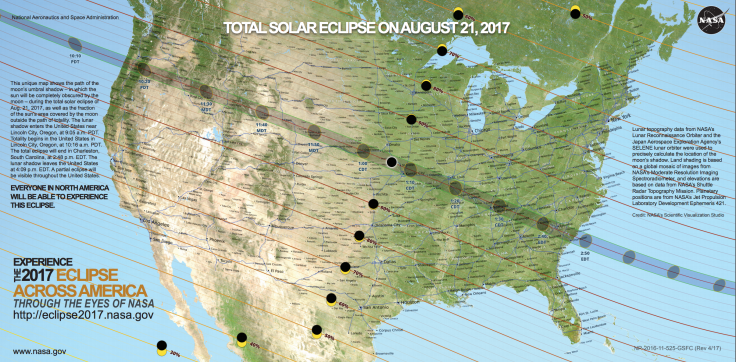Solar Eclipse 2017: How To Watch In VR, AR And Google Earth

The Great American Solar Eclipse, the first solar eclipse to take place across the U.S. since 1918 is expected to take place on Monday. If you think investing in a pair of eclipse glasses is a waste and won’t provide you the front-row feeling for watching the natural spectacle, there are alternatives available.
The eclipse has become a not-to-be-missed event since it is happening for the first time in 99 years.
You can now watch the eclipse in virtual reality (VR). CNN will showcase the eclipse in virtual reality at 1 p.m. on Monday. You can view it using a Samsung Gear VR headset and the Samsung VR app and visiting http://cnn.it/watcheclipse on your connected device. Once you go live, you can simply veer left and right to get a 360-degree feel of watching the eclipse.
If you want to get a realistic feel of the eclipse, the Weather Channel has set up an augmented reality (AR) display of the total solar eclipse.
The AR demonstration shows the alignment of the sun, moon and earth during the solar eclipse. It also shows how the penumbra (outer region) and umbra (inner region) of the moon's shadow will be cast on Earth.
You can also use Google Earth to watch the eclipse. Post a recent update, Google Earth will let you watch the eclipse in VR using the HTC Vive or Oculus Rift.
The moon’s dark shadow will completely blot out the sun as it moves, at a speed of 1,700 miles per hour, on a special path from Oregon to South Carolina. Anyone on this path will experience total darkness for a few minutes.
A new menu function in Google Earth will let the user activate the eclipse in VR and watch as it passes through 14 U.S. states: Georgia, Idaho, Illinois, Iowa, Kansas, Kentucky, Missouri, Montana, Nebraska, North Carolina, Oregon, South Carolina, Tennessee, and Wyoming.
A user can navigate where they want to see the eclipse from in the destinations menu in the software — the default area is set to rural Oregon, given that it is the starting point of the eclipse. You will also be able to navigate around your hometown in VR during the eclipse and get a space-vantage point.
You can drag and drop your cursor on the sun and see it as it goes from dark to lit up. Most importantly, you will actually control the movement and see where the moon starts and ends blocking the sun.
There are many ways to watch the solar eclipse without risking burning your retinas. These ways of viewing the eclipse are also ideal for children as it can educate and engage them while keeping them away from the risk of getting injured while trying to watch the solar eclipse. An added precaution would be to not look at the eclipse through a telescope, binoculars or other optical instruments.
Finally, if you normally wear eyeglasses, the best thing to do would be to keep them on during the solar eclipse.
© Copyright IBTimes 2024. All rights reserved.





















